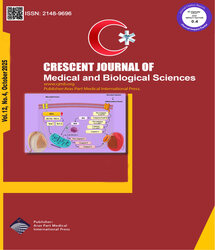

| Original Article | |
| A Study of the Therapeutic Effects of Vitamin E on Testicular Tissue Damage Caused by Fluoxetine | |
| Tohid Jalili1, Arash Khaki2, Zahra Ghanbari3, Amir Mahdi Imani4, Farzam Hatefi5 | |
| 1Department of Pathology, College of Vet Medicine, Tabriz Branch, Islamic Azad University, Tabriz, Iran 2Women’s Reproductive Health Research Center, Tabriz University of Medical Sciences, Tabriz, Iran 3Department of Pediatrics, Faculty of Medicine, Zanjan University of Medical Sciences, Zanjan, Iran 4Department of Histopathology, Sari Branch, Islamic Azad University, Sari, Iran 5Department of Pathology, College of Veterinary Medicine, Tabriz Branch, Islamic Azad University, Tabriz, Iran |
|
|
CJMB 2014; 1: 037-041 Viewed : 5836 times Downloaded : 3993 times. Keywords : Fluoxetine, Testis, Testosterone, Vitamin E |
|
| Full Text(PDF) | Related Articles | |
| Abstract | |
Objective: Fluoxetine is widely used in the treatment of neurological disorders. Hence, considering the
adverse effects of this drug on the endocrine axes of the body is very important. Fluoxetine has been
shown to cause significant changes in testicular tissue structure and sex hormones in rats. It seems that
antioxidant compounds such as vitamin E can reduce free radicals and inhibit these changes. Therefore,
the aim of this study is to investigate the therapeutic effects of vitamin E on testicular tissue damage
caused by fluoxetine use. Materials and Methods: In the present study, 40 Wistar rats (weight = 250 ± 10 gr) were randomly divided into 4 groups; control group that received normal saline (with intraperitoneal (IP) method), fluoxetine group (n = 10) that received 10 mg/kg of fluoxetine (IP), vitamin E group (n = 10 that received 100 mg/kg of vitamin E (IP), and the treatment group that received both vitamin E (100 mg/kg) and fluoxetine (10 mg/kg) for 28 days. On the 28th day of the study testis tissue was removed and sent to the pathology lab and blood samples were taken for analyzing of testosterone and total antioxidant capacity. Results: The highest testosterone levels are related to the control group and the lowest levels are related to the fluoxetine receiving group. Significant differences were observed between sperm density in the seminiferous tubes, spermatogonia cells, and primary spermatocyte, and leydig and sertoli cells in the experimental groups compared to the control group after a 28-day period. Conclusion: Fluoxetine can damage the leydig cells and decrease activity of testis and production of testosterone, but vitamin E can repair the leydig cells and reduce damages caused by fluoxetine. |
Cite By, Google Scholar
Google Scholar
PubMed
Online Submission System
 CJMB ENDNOTE ® Style
CJMB ENDNOTE ® Style
 Tutorials
Tutorials
 Publication Charge
Medical and Biological Research Center
About Journal
Publication Charge
Medical and Biological Research Center
About Journal
Aras Part Medical International Press Editor-in-Chief
Arash Khaki
Deputy Editor
Zafer Akan

















